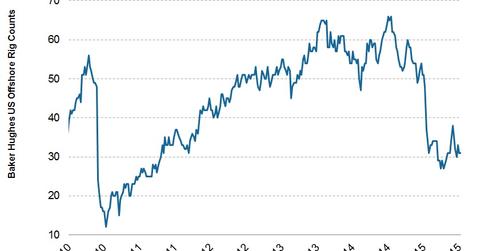US Offshore Rig Count Was Steady in the September 18 Week
In the week ending September 18, 2015, the US offshore rig count didn’t change. The offshore rig counts have averaged 33 over the past eight weeks.
Dec. 4 2020, Updated 10:52 a.m. ET

US offshore rig count
In the week ending September 18, 2015, the US offshore rig count didn’t change. It stayed at 31 rigs—compared to the previous week. The offshore rig counts have averaged 33 over the past eight weeks. The offshore rig count is 53% off its four-year high of 66 in August 2014. US offshore rig count fell four times in the past six weeks.
Offshore wells are more expensive than onshore wells, but they have much longer production lives. Offshore projects also have long lead times. Falling crude oil prices don’t affect planned offshore projects in the short term. According to the industry news organization Rigzone, 31 new GOM (Gulf of Mexico) well exploration permits were approved in 1H15. This is the same as a year ago.
The Louisiana section of the GOM accounts for almost all of the US offshore drilling. According to the EIA’s (U.S. Energy Information Administration) STEO (Short-Term Energy Outlook) report published in September, 12 projects are expected to come online in the GOM in 2015 and 2016.
Rig utilization
According to Rigzone, the utilization of jack-up rigs stood at 60% on September 18, 2015. In comparison, the utilization was ~78% a year ago. Offshore rig counts indicate how busy rig operators like Transocean (RIG) and Ensco (ESV) are at any given time. Offshore rig counts can also determine the activity levels of subsea oilfield service equipment and technology providers like Cameron International (CAM) and FMC Technologies (FTI). Rig counts also help investors foresee revenue trends for offshore rig equipment manufacturers like Oil States International (OIS). Ensco accounts for 2.90% of the VanEck Vectors Oil Services ETF (OIH).
Jack-up rigs are mobile offshore drilling units that perform drilling and workover operations to lift energy. Rigzone estimates that the use of jack-up rigs will likely fall below 50% in 2015 due to lower crude oil prices.
Trends in the offshore rig count also indicate offshore energy activity by upstream and integrated energy companies. ExxonMobil (XOM) and Royal Dutch Shell (RDS.A) have offshore operations.
A weak rig count in the GOM can push production levels lower. This can negatively affect midstream MLPs like Energy Products Partners (EPD), Shell Midstream Partners (SHLX), and MarkWest Energy Partners (MWE) that operate in the GOM region.
